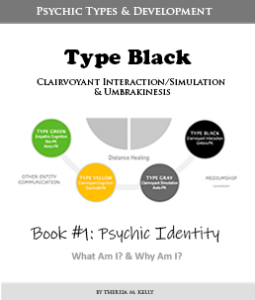- What Am I? (Type Gray)
- Psychic “Ability” (Type Gray)
- Psi, ESP, & Clairvoyance (Type Gray)
- Dreams, Impressions, & Hallucinations (Type Gray)
- Clairvoyant Simulation (Type Gray)
- Input – Clairvoyant Simulation (Type Gray)
- Output – Probability Shifting (Type Gray)
- Output – Historical Shifting (Type Gray)
- Changing the Past (Type Gray)
- Intention (Type Gray)
- Adaptive or Directive? (Type Gray)
- Input & Output Clairvoyant Simulation (Type Gray)
- People, Places, Objects, & Ideas (Type Gray)
- Precognition & Probability Shifting (Type Gray)
- Real-Time Clairvoyance (Type Gray)
- Postcognition & Historical Shifting (Type Gray)
- Psychic Episodes (Type Gray)
- Different Modes of Clairvoyant Simulation (Type Gray)
- Other Terms for Clairvoyant Simulation (Type Gray)
- You Are Not Alone: CS (Type Gray)
- Magical Thinking & Psychic Confusion (Type Gray)
- The Difference Between Types of ESP (Type Gray)
- Having Doubts:CS (Type Gray)
- Psychokinesis (Type Gray)
- Forms of Psychokinesis (Type Gray)
- PK or CS Healer? (Type Gray)
- Science Crash Course (Type Gray)
- Autokinesis (Type Gray)
- PK Thermal Influence (Type Gray)
- PK Light Influence (Type Gray)
- PK Electrical Influence (Type Gray)
- You Are Not Alone: Auto-PK (Type Gray)
- Probability Shifting or Autokinesis? (Type Gray)
- Having Doubts? (Type Gray)
- 1 Last Question (Type Gray)
- Ninja jk
DIFFERENCE BETWEEN CS & OTHER ESP
 In Clairvoyant Cognition, the experiencer sees everything that is happening. From this way of seeing things, the experiencer’s viewpoint is not through the eyes of someone in the situation. Rather, the experiencer’s viewpoint is from outside of the situation and may involve one or more people.
In Clairvoyant Cognition, the experiencer sees everything that is happening. From this way of seeing things, the experiencer’s viewpoint is not through the eyes of someone in the situation. Rather, the experiencer’s viewpoint is from outside of the situation and may involve one or more people.
Here the story is being told in the third-person perspective, that is to say, the story is being told by someone outside of the situation and refers to people in the situation as “he,” “she,” “they,” and so forth. The situation or people in the situation are usually viewed from above and off to the side.
Let’s put it this way, if you were filming a movie from this way of seeing things, the camera would be off into the distance so that the whole set and all the characters can be seen.
 In Telepathic Cognition, the experiencer’s viewpoint is through the eyes of someone in a situation or looking at a situation.
In Telepathic Cognition, the experiencer’s viewpoint is through the eyes of someone in a situation or looking at a situation.
Here a story is being told in the first-person perspective, that is to say, the person tells the story of what they see, and the story is told by the person, and the information is expressed as “I see,” or “I hear,” in reference to the person, not the experiencer.
The situation or other people are usually viewed at eye-level. If you were filming a movie from this way of seeing things, one of the characters would be holding the camera.
 In Clairvoyant Simulation, the experiencer’s viewpoint is their own. Here the story is being told by both the experiencer and the universe, but the experiencer is unaware of the universe’s part in telling the story.
In Clairvoyant Simulation, the experiencer’s viewpoint is their own. Here the story is being told by both the experiencer and the universe, but the experiencer is unaware of the universe’s part in telling the story.
Here, the information is expressed as “I see,” or “I hear,” or “I feel,” referring only to the experiencer. The object or person of interest is usually the only thing viewable.
If you were filming a movie from this way of seeing things, you would be holding the camera and zoomed in on the object or person of interest and not showing the surrounding situation or background.
 In Clairvoyant Interaction, there is a sharing of the body and mind with an entity or spirit rather than a sharing of ideas.
In Clairvoyant Interaction, there is a sharing of the body and mind with an entity or spirit rather than a sharing of ideas.
Here, a spirit can talk through the experiencer and even move the experiencer’s body. The spirit has a different personality, and the experiencer may speak with another voice.
 In Telepathic Simulation, there is a sharing of information, but it is obviously between the experiencer and another person or group of people.
In Telepathic Simulation, there is a sharing of information, but it is obviously between the experiencer and another person or group of people.







